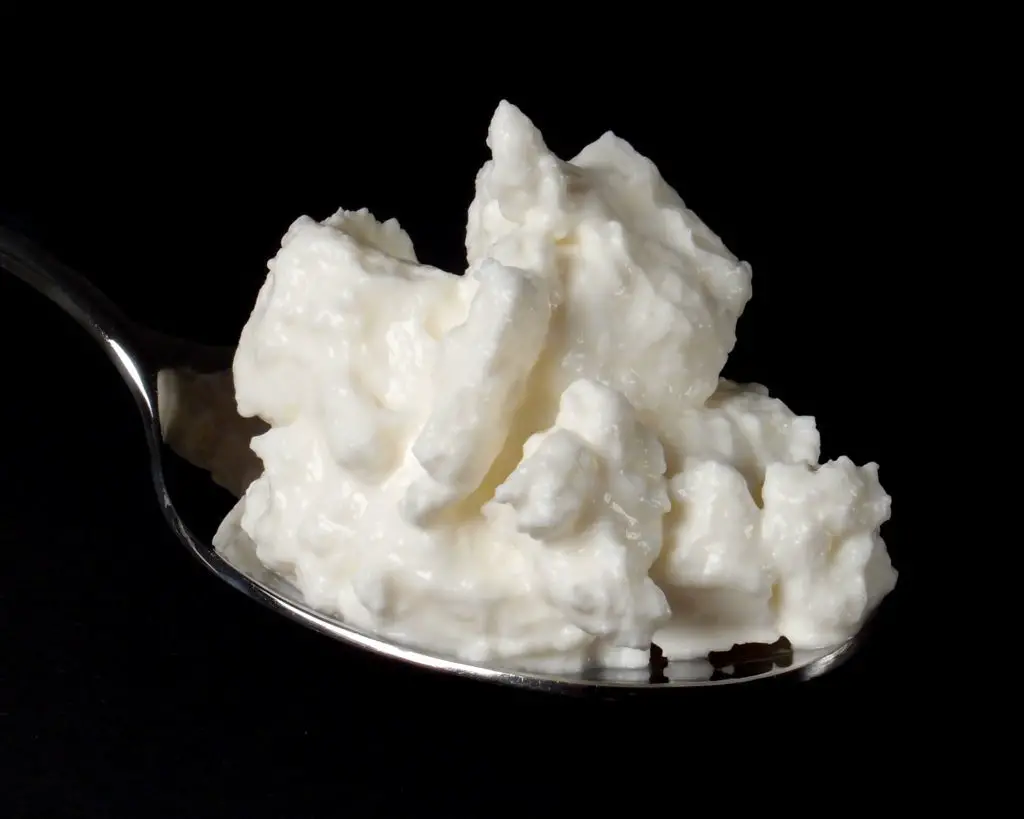Most of us know the traditional look of cottage cheese found in grocery stores. It has lumpy parts known as curds that vary from large to small size. It also has a creamy (liquid) portion that is on top, in-between, and under the curds. This liquid is cream/milk that is added to the cottage cheese after the curds form. This traditional type of cottage cheese that is popular commercially in the United States is sometimes called “wet-curd” cottage cheese.
Dry curd cottage cheese (dccc) can also be called farmer’s cheese, quark, or baker’s cheese depending on who you ask. It is made similar to wet-curd cottage cheese, but the milk/cream is not added at the end. Basically, you have something that looks like crumbly feta cheese that does not have the wetness of common grocery store cottage cheese. The ingredients of dry curd cottage cheese in its purest form will be curdled milk and salt. This is especially true if you make it at home.
Nutritionally speaking, dry curd cottage cheese is extremely low in lactose because during the curdling process the lactose is fermented out of the product. By low, we mean about 0.5% lactose. In comparison, wet-curd cottage cheese has about 3% lactose. Wet-curd cottage cheese has higher lactose because the cream/milk that is added to the curds has lactose (milk sugar). Many people can eat dry curd cottage cheese while having lactose intolerance since it is so low in lactose content.
Dry curd cottage cheese has the following nutrition facts in comparison to regular cottage cheese:
Dry Curd vs Regular Cottage Cheese Nutrition Facts
| Cottage Cheese Variety | Serving Size | Calories | Calories from Fat | Total Fat | Saturated Fat | Tran Fat | Cholesterol | Sodium | Carbohydrates | Dietary Fiber | Sugars | Protein | Vitamin A (% dv) | Vitamin C (% dv) | Calcium (% dv) | Iron (% dv) |
|---|---|---|---|---|---|---|---|---|---|---|---|---|---|---|---|---|
| Dry, nonfat, uncreamed (large or small curd) | 1 Cup (149g) - Not Packed | 104 | 4 | 0 | 0 | 0 | 10 | 478 | 10 | 0 | 3 | 15 | 0% | 0% | 12% | 1% |
| Regular Cottage Cheese Lowfat 1% | 1 Cup (226g) - Not Packed | 163 | 20 | 2 | 1 | 0 | 9 | 918 | 6 | 0 | 6 | 28 | 2% | 0% | 14% | 2% |
| Regular Cottage Cheese Lowfat 2% | 1 Cup (226g) - Not Packed | 194 | 49 | 6 | 2 | 0 | 23 | 746 | 8 | 0 | 8 | 27 | 3% | 0% | 21% | 2% |
| Regular Cottage Cheese 4% | 1 Cup (226g) - Not Packed | 222 | 86 | 10 | 4 | 0 | 38 | 822 | 8 | 0 | 6 | 26 | 3% | 0% | 9% | 0% |
You can see a huge difference between the nutritional information of dry curd cottage cheese vs. regular cottage cheese. This is particularly true when comparing dry curd and full fat (4% creamed) cottage cheese. The calorie difference alone is over 100 calories higher for the 4% cottage cheese. Dry curd is also much lower in sodium than regular cottage cheese, therefore, it may be more suitable to eat for those watching their sodium intake.
Where to buy dry curd cottage cheese?
Dry curd cottage cheese is not as common as regular cottage cheese and is not usually easy to find in stores. If your local store carries it, it may be located with the specialty cheeses and not adjacent to regular cottage cheese. It may be labeled farmer’s cheese and possibly baker’s cheese so keep an eye out for these names.

